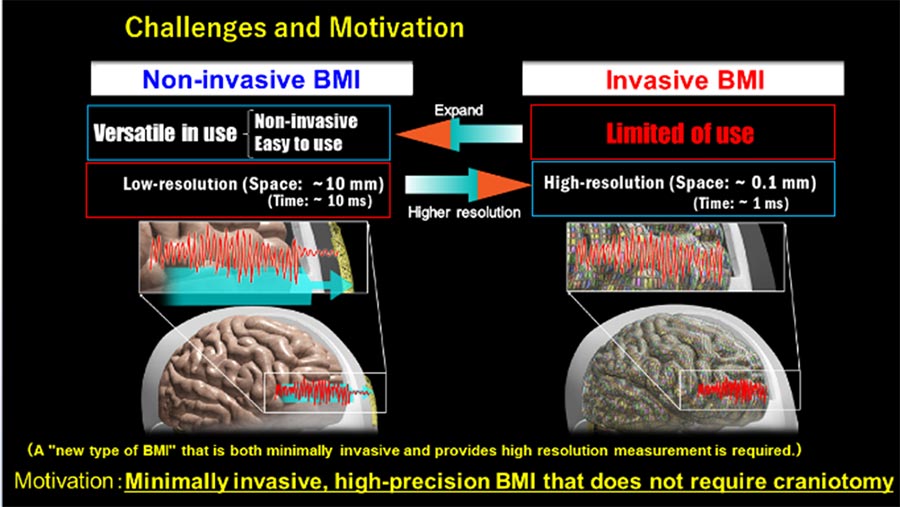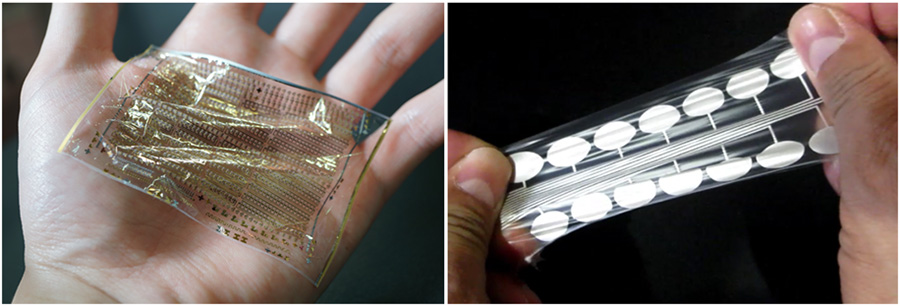Progress Report
Liberation from Biological Limitations via Physical, Cognitive and Perceptual Augmentation5. Research and Development of Minimally Invasive BMI
Progress until FY2022
1. Outline of the project
Recently, the number of patients with brain-related diseases and diseases of the central nervous system has been increasing enormously, and the existing technologies to date have not even begun to solve the problems. This is due to the critical lack of measurement technology to accurately measure advanced brain activity, measurement results to statistically process brain activity, and means to construct brain big data.

Based on the above background, we are conducting research and development to build a "flexible ultra-thin BMI system" that achieves high measurement accuracy of brain information in an extremely minimally invasive manner (no craniotomy required).
2. Outcome so far
A research team at Osaka University is working toward minimally invasive and detailed measurement of brain activity. So far, two types of devices have been developed with the goal of realizing the following two types of devices. One is an "extremely minimally invasive BMI system" using an ultra-fine and soft intravascular implantable device, and the other is an "intravascular BMI transporter" to deliver the developed BMI system to the desired location within the blood vessel. Furthermore, a signal processing circuit and system to deliver the measured intravascular EEG signals to the outside of the body with high quality.

In order to realize accurate EEG signal measurement without damaging soft blood vessels in the body, R&D has been conducted utilizing thin-film electronics technology as shown in the above figure 2. Specifically, R&D has been conducted to realize a minimally invasive BMI system by utilizing ultra-thin and ultra-lightweight electronic devices with a thickness of 1 µm and stretchable and flexible electrode technology.
Examples of past R&D results include the realization of signal amplification circuits using biocompatible semiconductor materials, the development of technology to control the characteristics of flexible electronic circuits using optical technology. Publications are listed below.
- Science 380, 690 (2023) 【IF: 63.832】
- Advanced Electronic Materials 2201333 (2023). 【IF: 7.633】
- Advanced Science 10, 220474 (2022). 【IF: 17.521】
- Communication Biology 5, 1375 (2022). 【IF: 6.548】
- ACS Applied Electronic Materials 4, 6308 (2022). 【IF: 4.494】
- Flexible and Printed Electronics 7, 44002 (2022). 【IF: 3.768】
3. Future plans
Development and evaluation of this device is currently underway at the preeminent medical device research and development facility. The team plans to verify the quality of EEG measurement signals using the minimally invasive BMI system currently under development, to verify the device and system, and to verify the stability of the system after long-term implantation.
In parallel, we will also develop a wireless transmission system to transmit the EEG measurement signals outside the body and a wireless power supply system to supply power to the measurement devices inside the body.
Through these efforts, a new type of BMI that can measure high-level brain activity over a long period of time without the need for craniotomy will be realized, contributing to medical care and health care.